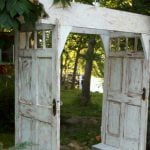Hedging is a great way to define boundaries, add privacy, and create visual interest in small gardens. It not only provides a sense of enclosure but also serves as a beautiful backdrop for other plants and features. In this article, we will delve into the world of hedging ideas specifically tailored for small garden spaces, offering practical tips and creative solutions to make the most out of limited areas.
When it comes to choosing the right plants for hedging in small gardens, considerations such as size, growth habit, and maintenance requirements play a crucial role. Selecting plants that are well-suited to the space available can help create a cohesive and harmonious landscape. Additionally, design strategies can be implemented to maximize space utilization and enhance aesthetic appeal.
Whether you have a contemporary or traditional garden style, there are various low-maintenance hedging plants that can thrive in small spaces. Proper planting techniques and regular care are essential for ensuring the health and longevity of your hedge. By exploring innovative ways to incorporate hedging into your landscaping scheme, you can transform your small garden into a charming oasis that reflects your personal style.
Choosing the Right Plants for Small Garden Hedging
Hedging ideas for small gardens require careful consideration to ensure the plants chosen are suitable for the limited space available. When selecting plants for small garden hedging, it is essential to choose varieties that will not only thrive in the conditions of your garden but also maintain a compact and tidy form. Here are some key factors to keep in mind when choosing the right plants for small garden hedging:
- Size: Opt for compact or dwarf varieties that won’t outgrow their designated space. Consider both height and spread to ensure they fit well within the confines of your garden.
- Adaptability: Select hedging plants that are resilient and can tolerate the specific growing conditions in your garden, such as sun exposure, soil type, and moisture levels.
- Aesthetic appeal: Choose plants with interesting foliage, flowers, or berries to add visual interest to your small garden. Consider how they will look throughout the seasons to ensure year-round beauty.
Incorporating a mix of different plant species can also enhance the overall aesthetic of your small garden while providing biodiversity and attracting beneficial wildlife. Some popular options for small garden hedging include boxwood, lavender, euonymus, holly, and hebe. These plants offer a combination of practicality, beauty, and ease of maintenance that make them ideal choices for smaller outdoor spaces.
When planning your small garden hedge, it’s important to consider the ultimate purpose of the hedge – whether it be creating privacy from neighbors, defining boundaries within your garden, or simply adding structure and visual appeal. By carefully selecting the right plants for your specific needs and space constraints, you can create a beautiful and functional hedge that enhances the overall look of your small garden.
Design Tips for Maximizing Space and Creating Visual Interest
When it comes to incorporating hedging into small garden spaces, maximizing the available area and creating visual interest are key aspects to consider. One effective tip is to opt for slender, upright hedge plants that will not encroach too much on the limited space. These plants not only provide structure and privacy but also help create a sense of height in the garden without overwhelming the area.
Layering and Variation
Another design tip for small garden hedging is to consider layering different types of plants to add depth and dimension. By mixing various heights, textures, and colors, you can create a visually appealing hedge that adds interest to your garden. For example, combining low-growing evergreens with taller flowering shrubs can enhance the overall look of your hedge while maximizing space.
Creating Focal Points
Incorporating focal points within your small garden hedging design can help draw the eye and create a sense of balance. Consider adding a specimen plant or ornamental tree as a focal point amidst your hedge to break up the greenery and provide visual interest. This can also serve as a unique feature that adds character to your garden while making the most of limited space.
Utilizing Vertical Space
To make the most out of a small garden when hedging, consider utilizing vertical space by incorporating trellises or espalier techniques. These methods allow you to grow plants vertically against walls or fences, adding another layer of depth to your hedge design while saving valuable ground space. Climbing plants like ivy or clematis can be trained along these structures to create an interesting backdrop for your hedging.
Top Low-Maintenance Hedging Plants Ideal for Small Gardens
When it comes to creating a beautiful and functional hedging design for small gardens, choosing the right plants is essential. Opting for low-maintenance hedging plants can save you time and effort while still achieving the desired look. Here are some top low-maintenance hedging plants that are ideal for small garden spaces:
- Boxwood (Buxus sempervirens): Boxwood is a classic choice for hedging in small gardens due to its compact size and evergreen foliage. It requires minimal pruning and thrives in both sun and partial shade.
- Lavender (Lavandula angustifolia): Lavender not only adds beauty to your garden with its fragrant blooms but also serves as a great low-maintenance hedge. It is drought-tolerant and attracts beneficial pollinators.
- Dwarf Yaupon Holly (Ilex vomitoria ‘Nana’): This slow-growing holly variety is perfect for creating a formal or informal hedge in small gardens. Its dense foliage provides year-round interest with minimal upkeep required.
These low-maintenance hedging plants not only offer ease of care but also contribute to the overall aesthetic appeal of your small garden. By incorporating these options into your landscaping design, you can enjoy a beautifully edged space without the need for constant maintenance.
Remember, when selecting hedging plants for your small garden, consider factors such as sunlight exposure, soil quality, and the desired height of the hedge. By choosing species that thrive in your specific conditions, you can ensure that your hedge will flourish with minimal intervention, allowing you to enjoy your garden space without any unnecessary hassle.
How to Properly Plant and Care for Hedging in Limited Space
Planting and caring for hedging in limited space can be a rewarding experience, adding beauty and privacy to your small garden. When it comes to choosing the right plants for your small garden hedge, consider factors such as the amount of sun exposure, soil quality, and the overall aesthetic you want to achieve. Some popular options for small gardens include boxwood, lavender, and Japanese holly due to their compact growth habits and low maintenance requirements.
Proper spacing is crucial when planting a hedge in a confined area. Make sure to follow the recommended distance between each plant to allow them room to grow while still creating a dense hedge for privacy. Regular watering and occasional feeding with a balanced fertilizer will help keep your hedge healthy and thriving. Additionally, pruning is essential to maintain the shape and density of your hedge in limited space.
It’s important to remember that different types of hedges may have specific care requirements, so be sure to research the needs of your chosen plants. With some careful planning and regular upkeep, you can enjoy the beauty and functionality of a well-maintained hedge in even the smallest of garden spaces.
| Benefits of Hedging in Small Gardens | Hedging Plants Ideal for Small Gardens |
|---|---|
| Enhances privacy | Boxwood |
| Adds visual interest | Lavender |
| Defines boundaries | Japanese holly |
Creative Ways to Incorporate Hedging Into Small Garden Landscaping
Incorporating hedging into small garden landscaping can add depth, texture, and structure to your outdoor space. When working with limited space, it’s important to get creative with how you use hedging to make the most of your garden. Here are some innovative ideas to consider:
Vertical Hedging
One way to maximize space in a small garden is to utilize vertical hedging. Consider planting taller hedge plants along fences or walls to create a natural boundary that also adds height to your garden. This not only creates privacy but also draws the eye upwards, making the space feel larger.
Curved Borders
Instead of traditional straight-line hedges, try incorporating curved borders into your small garden design. Curved hedges can help soften the edges of a space and create a more organic, flowing feel. Use shorter hedge plants like boxwood or lavender for these curved borders to maintain an elegant look without overwhelming the space.
Mixing Textures and Colors
Get creative with your choice of hedge plants by mixing different textures and colors in your small garden. Combine evergreen shrubs with colorful flowering plants or variegated foliage for added visual interest. This not only adds dimension to your hedge but also creates a dynamic and vibrant landscape.
By incorporating these creative ideas for using hedging in small gardens, you can transform your outdoor space into a lush and inviting oasis that makes the most of limited square footage. Remember to choose the right plants for your specific climate and growing conditions, and don’t be afraid to experiment with different designs until you find one that fits your style and preferences.
Solutions for Common Challenges When Hedging in Small Gardens
One common challenge when it comes to hedging in small gardens is limited space. It can be tricky to find the right balance between creating a lush, green boundary for your garden while not overwhelming the available area.
One solution to this challenge is to opt for dwarf or compact varieties of hedging plants. These species are specifically designed to thrive in smaller spaces and require less frequent pruning, making them ideal for maintaining a neat appearance without crowding your garden.
Another challenge that gardeners face when hedging in small gardens is ensuring proper airflow and sunlight penetration. Dense hedges can block light and airflow, leading to issues such as mold or disease on plants. To overcome this challenge, consider incorporating a mix of different plant species in your hedge. By combining plants with different growth habits and foliage densities, you can create a more porous hedge that allows light and air to circulate more freely throughout your garden.
Additionally, maintaining privacy without sacrificing precious garden space can be another common challenge for small garden owners looking to hedge their boundaries. A creative solution is to use trellises or screens in conjunction with low-growing hedging plants.
This layered approach not only adds visual interest to your garden but also provides additional height for privacy screening without taking up valuable ground space. By thinking outside the box and combining different elements in your hedge design, you can overcome the challenges of limited space while still achieving the desired aesthetic in your small garden.
| Challenge | Solution |
|---|---|
| Limited Space | Opt for dwarf or compact varieties of hedging plants |
| Airflow and Sunlight | Incorporate a mix of different plant species for a more porous hedge |
| Privacy Screening | Use trellises or screens with low-growing hedging plants |
Inspiration and Ideas for Unique Hedging Designs in Small Garden Spaces
When it comes to unique hedging designs in small garden spaces, the possibilities are endless. From geometric patterns to whimsical shapes, incorporating hedging into your small garden can truly transform the space. One creative idea is to create a maze-like design using low-maintenance hedging plants, providing both visual interest and a fun element for visitors to navigate through.
Another inspiring concept for unique hedging designs in small garden spaces is to mix different types of plants to create a vibrant and diverse hedge. By combining various colors, textures, and heights, you can achieve a dynamic and visually appealing border that adds depth and dimension to your garden. Additionally, mixing fragrant plants with evergreens can enhance the sensory experience of your outdoor space.
Consider incorporating vertical elements such as trellises or archways into your hedging design to add height and structure to your small garden. This not only creates a focal point but also maximizes space by utilizing vertical surfaces. By thinking outside the box and experimenting with different plant combinations and architectural features, you can personalize your small garden hedge to reflect your own unique style and taste while creating a stunning botanical display that enhances the beauty of your outdoor oasis.
Frequently Asked Questions
What Is the Best Small Hedging to Plant?
The best small hedging plant depends on various factors such as climate, soil conditions, and desired appearance. Some popular options include boxwoods, privets, yews, and hollies. These plants are known for their dense growth and can be easily pruned to maintain a neat hedge.
What Plant Makes the Perfect Hedge?
Boxwoods are often considered the perfect plant for creating hedges due to their versatility and resilience. They have small evergreen leaves that create a dense screen when planted close together. Boxwoods can thrive in different sunlight conditions and are relatively low-maintenance, making them ideal for hedging.
What Are Good Ideas for Hedges?
When considering ideas for hedges, it’s essential to think about the purpose of the hedge – whether it is for privacy, aesthetics, or to define boundaries. Some good ideas for hedges include using a mix of evergreen and deciduous plants to ensure year-round coverage, varying heights to create visual interest, selecting plants with attractive foliage or flowers, and incorporating edible plants like fruiting shrubs or herbs for a functional hedge that also provides food.
Ultimately, the best hedge design will depend on individual preferences and specific needs of the space where it will be planted.

Welcome to my gardening blog! I am passionate about plants and enjoy sharing my knowledge and experiences with others. In this blog, I will write about everything related to gardening, from tips on how to get started to updates on my own garden projects.





